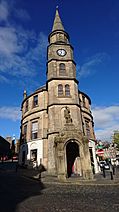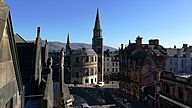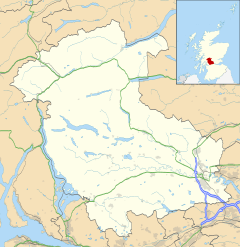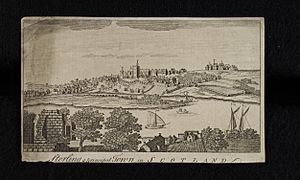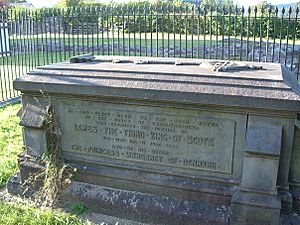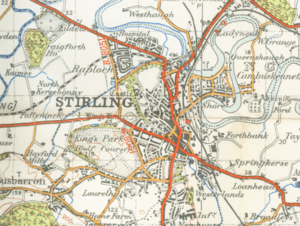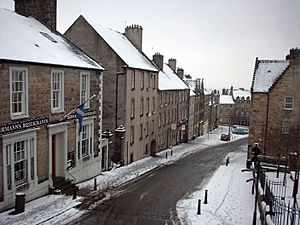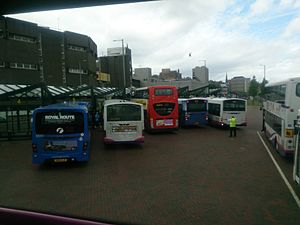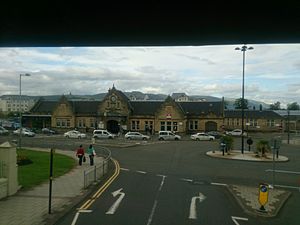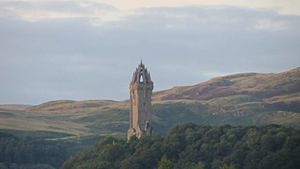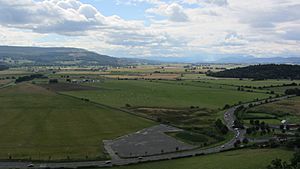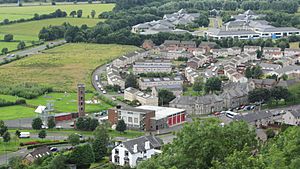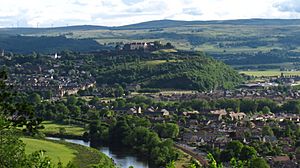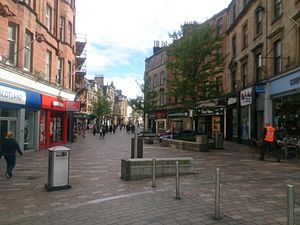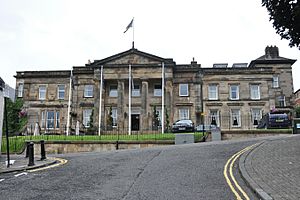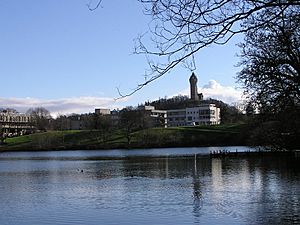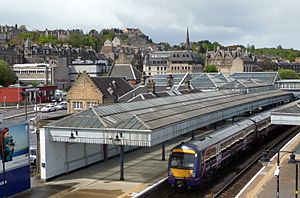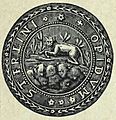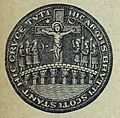Stirling facts for kids
Quick facts for kids Stirling
|
|
|---|---|
| City and administrative centre | |
|
From top, left to right: Skyline of Stirling, Stirling Old Bridge, Stirling Castle, Statue of William Wallace, the Wallace Monument, The Athenaeum, Stirling Tolbooth, View towards Burgh Buildings |
|
| Area | 16.7 km2 (6.4 sq mi) |
| Population | 37,910 (2020) |
| • Density | 2,270/km2 (5,900/sq mi) |
| OS grid reference | NS795935 |
| • Edinburgh | 43 mi (69 km) |
| Civil parish |
|
| Council area | |
| Lieutenancy area |
|
| Country | Scotland |
| Sovereign state | United Kingdom |
| Post town | STIRLING |
| Postcode district | FK7–FK9 |
| Dialling code | 01786 |
| Police | Central Scotland |
| Fire | Central Scotland |
| Ambulance | Scottish |
| EU Parliament | Scotland |
| UK Parliament |
|
| Scottish Parliament |
|
Stirling ( Scots: Stirlin; Scottish Gaelic: Sruighlea) is a city in central Scotland, 26 miles (42 km) northeast of Glasgow and 37 miles (60 km) north-west of Edinburgh. The market town, surrounded by rich farmland, grew up connecting the royal citadel, the medieval old town with its merchants and tradesmen, the Old Bridge and the port. Located on the River Forth, Stirling is the administrative centre for the Stirling council area, and is traditionally the county town of Stirlingshire. Proverbially it is the strategically important "Gateway to the Highlands".
It has been said that "Stirling, like a huge brooch clasps Highlands and Lowlands together". Similarly "he who holds Stirling, holds Scotland" is often quoted. Stirling's key position as the lowest bridging point of the River Forth before it broadens towards the Firth of Forth made it a focal point for travel north or south.
When Stirling was temporarily under Anglo-Saxon sway, according to a 9th-century legend, it was attacked by Danish invaders. The sound of a wolf roused a sentry, however, who alerted his garrison, which forced a Viking retreat. This led to the wolf being adopted as a symbol of the town as is shown on the 1511 Stirling Jug. The area is today known as Wolfcraig. Even today the wolf appears with a goshawk on the council's coat of arms along with the recently chosen motto: "Steadfast as the Rock".
Once the capital of Scotland, Stirling is visually dominated by Stirling Castle. Stirling also has a medieval parish church, the Church of the Holy Rude, where, on 29 July 1567, the infant James VI was anointed King of Scots by Adam Bothwell, the Bishop of Orkney, with the service concluding after a sermon by John Knox. The poet King was educated by George Buchanan and grew up in Stirling. He was later also crowned King of England and Ireland on 25 July 1603, bringing closer the countries of the United Kingdom. Modern Stirling is a centre for local government, higher education, tourism, retail, and industry. The mid-2012 census estimate for the population of the city is 36,440; the wider Stirling council area has a population of about 93,750.
One of the principal royal strongholds of the Kingdom of Scotland, Stirling was created a royal burgh by King David I in 1130. In 2002, as part of Queen Elizabeth's Golden Jubilee, Stirling was granted city status.
Contents
History
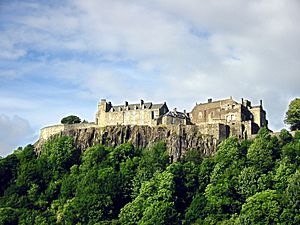
Stirling was originally a Stone Age settlement as shown by the Randolphfield standing stones and Kings Park prehistoric carvings that can still be found south of the town. The city has been strategically significant since at least the Roman occupation of Britain, due to its naturally defensible crag and tail hill (latterly the site of Stirling Castle), and its commanding position at the foot of the Ochil Hills on the border between the Lowlands and Highlands, at the lowest crossing point of the River Forth. It remained the river's lowest crossing until the construction of the Kincardine Bridge further downstream in the 1930s. It is supposed that Stirling is the fortress of Iuddeu or Urbs Giudi where Oswiu of Northumbria was besieged by Penda of Mercia in 655, as recorded in Bede and contemporary annals.
A ford, and later bridge, of the River Forth at Stirling brought wealth and strategic influence, as did its port. The town was chartered as a royal burgh by King David in the 12th century, with charters later reaffirmed by later monarchs (the town then referred to as Strivelyn). Major battles during the Wars of Scottish Independence took place at the Stirling Bridge in 1297 and at the nearby village of Bannockburn in 1314 involving William Wallace and Robert the Bruce respectively. There were also several Sieges of Stirling Castle in the conflict, notably in 1304. Sir Robert Felton, governor of Scarborough Castle in 1311, was slain at Stirling in 1314.
The origin of the name Stirling is uncertain, but folk etymology suggests that it originates in either a Scots or Gaelic term meaning the place of battle, struggle or strife. Other sources suggest that it originates in a Brythonic name meaning "dwelling place of Melyn". The town has two Latin mottoes, which appeared on the earliest burgh seal of which an impression of 1296 is on record:
- Hic Armis Bruti Scoti Stant Hic Cruce Tuti (The Britons stand by force of arms, The Scots are by this cross preserved from harms) and
- Continet Hoc in Se Nemus et Castrum Strivilinse (The Castle and Wood of Stirling town are in the compass of this seal set down.)
Standing near the castle, the Church of the Holy Rude is one of the town's most historically important buildings. Founded in 1129 it is the second oldest building in the city after Stirling castle. It was rebuilt in the 15th century after Stirling suffered a catastrophic fire in 1405, and is reputed to be the only surviving church in the United Kingdom apart from Westminster Abbey to have held a coronation. On 29 July 1567 the infant son of Mary, Queen of Scots, was crowned James VI of Scotland here. Musket shot marks that may come from Cromwell's troops during the Wars of the Three Kingdoms are clearly visible on the tower and apse. Another important historical religious site in the area is the ruins of Cambuskenneth Abbey, the resting place of King James III of Scotland and his queen, Margaret of Denmark. During the Wars of the Three Kingdoms, the Battle of Stirling also took place in the centre of Stirling on 12 September 1648.
The fortifications continued to play a strategic military role during the 18th century Jacobite Risings. In 1715, the Earl of Mar failed to take control of the castle. On 8 January 1746 (OS) 19 January 1746 (NS), the army of Bonnie Prince Charlie seized control of the town but failed to take the Castle. On their consequent retreat northwards, they blew up the church of St. Ninians where they had been storing munitions; only the tower survived and can be seen to this day.
Economically, the city's port supported overseas trade, including tea trade with India and timber trade with the Baltic. The coming of the railways in 1848 started the decline of the river trade, not least because a railway bridge downstream restricted access for shipping. By the mid 20th century the port had ceased to operate.
Notable people
Famous residents have included Mary, Queen of Scots; King James VI of Scotland; Sir Henry Campbell-Bannerman; documentary film pioneer John Grierson; film music composer Muir Mathieson; animation pioneer Norman McLaren; TV presenter Kirsty Young; and footballers Billy Bremner (captain of Leeds United and Scotland) and Frank Beattie (captain of Kilmarnock). John Paton, recipient of the Victoria Cross, and Scots-Argentine pioneer chemist John Joseph Jolly Kyle, were from Stirling.
The Barnwell brothers, Frank and Harold, worked at Grampian Motors in Causewayhead, and in 1909 they designed and flew the first powered aircraft in Scotland. Frank Barnwell went on to design aircraft including the Bristol Blenheim. A small monument to the brothers' pioneering achievement has been erected at Causewayhead roundabout.
Geography
Stirling is renowned as the Gateway to the Highlands and is generally regarded as occupying a strategic position at the point where the flatter, largely undulating Scottish Lowlands meet the rugged slopes of the Highlands along the Highland Boundary Fault. The starkness of this contrast is evidenced by the many hills and mountains of the lower Highlands such as Ben Vorlich and Ben Ledi which can be seen to the northwest of the city. On the other hand, the Carse of Stirling, stretching to the west and east of the city, is one of the flattest and most agriculturally productive expanses of land in the whole of Scotland.
The land surrounding Stirling has been most affected by glacial erosion and deposition. The city itself has grown up around its castle which stands atop an ancient quartz-dolerite sill, a major defensive position which was at the lowest crossing point on the River Forth. Stirling stands on the Forth at the point where the river widens and becomes tidal. To the east of the city the Ochil Hills dominate the skyline with the highest peak in the range being Ben Cleuch, although Dumyat is more noticeable from Stirling. The Ochils meet the flat carse (floodplain) of the River Forth to the east of the distinctive geographical feature of Abbey Craig, a crag and tail hill upon which stands the 220 ft (67m) high Wallace National Monument.
The climate of Stirling differs little from that of much of the rest of central Scotland. The warm Gulf Stream air current from the Atlantic Ocean is the predominant influence, with a prevailing southwesterly wind. That said, the areas round Stirling Town Centre encounter significantly less snow in Winter than many of its very close neighbours such as Denny and Dunblane. Although this could be said as being anecdotal, it is likely to be because it is at a lower level and could be said to have its own microclimate.
Areas of Stirling
Top of the Town
Top of the Town consists of Broad Street, Castle Wynd, Ballengeich Pass, Lower Castle Hill Road, Darnley Street, Baker Street ( formerly Baxters St) and St Mary's Wynd. These streets all lead up to Stirling Castle and are the favourite haunt of tourists who stop off at the Old Town Jail, Mar's Wark, Argyll's Lodging and the castle. Ballengeich Pass leads to the graveyard at Ballengeich and the Castle Wynd winds past the old graveyard. The Top of the Town from Broad Street upwards is renowned for its cobblestoned roads, and cars can be heard rattling over the cobblestones on the way down. Craft shops and tourist-focused shops are evident on the way up and once at the top, panoramic views are available across Stirling and beyond.
Other areas
- Abbey Craig
- Airthrey
- Allan Park
- Bannockburn
- Borestone
- Braehead
- Broomridge
- Burghmuir
- Cambusbarron
- Cambuskenneth
- Causewayhead
- Chartershall
- Corn Exchange
- Cornton
- Coxethill
- Craigmill
- Craig Leith
- Cultenhove
- Forthbank
- Gillies Hill
- Gowan Hill
- Hillpark
- Kenningknowes
- Kildean
- King's Park
- Laurelhill
- Livilands
- Loanhead
- Mercat Cross
- Mote Hill
- Raploch
- Randolphfield
- Riverside
- Spittal Hill
- Springkerse
- St. Ninians
- Torbrex
- Whins of Milton
- Viewforth
- Wolfcraig
Demography
The settlement of Stirling had a population of 48,440 in 2012. According to the 2001 census, 52.7% of the population was female compared to 47.2% male. Stirling had both a smaller proportion of under 16s, at 16.7% compared to the Scottish average of 19.2%, and a smaller proportion of those of pensionable age: 17.8% – compared to the Scottish average of 18.6%. The highest proportion of the population, at 24.3%, was concentrated in the 16–29 age group. Stirling also had a higher proportion of non-Scottish born residents at 16.5%, compared to the Scottish average of 12.8%. The population was also slightly younger than the Scottish average of 37 – the median age for males was 34; and the median age for females was 36, to the national average of 39. The population peaks and troughs significantly when the students come and go from the city.
Historical records also exist both in book form and in online databases.
Culture
Stirling has hosted the National Mòd several times: in 1909, 1961, 1971,1987 and 2008.
Sports and recreation
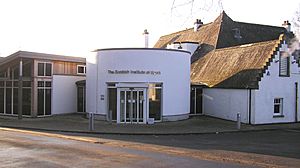
Stirling is home to professional league teams in football, rugby and cricket.
Marathon
The first Stirling Scottish Marathon was held on 21 May 2017.
Curling
The National Curling Academy is located in Stirling Sports Village. It was opened in 2017 by Eve Muirhead. They use facilities linked to The Peak. It was hoped this would increase the chances of British medals at events like the Winter Olympics and Paralympics.
Football
Men
The senior football team, Stirling Albion, play in the Scottish League Two at their home ground at Forthbank Stadium. In July 2010, the Stirling Albion Supporters' Trust successfully took over the running of the club buying out the long-serving chairman, Peter McKenzie, after 14 months of campaigning. This made Stirling Albion the first fully owned community club in the history of British football, after previous attempts made by Manchester United, Liverpool and Rangers.
Women
Stirling University L.F.C. are the premier women's football team. They play in the Scottish Women's Premier League. Their home ground is The Gannochy Sports Centre at Stirling University.
Rugby
Stirling County currently play in rugby's Scottish Premiership Division One.
Basketball
Stirling Knights Basketball Team are based at the Peak at Forthbank beside Forthbank Stadium.
Athletics
The athletics team Central Athletic Club are based at the University of Stirling.
Hockey
The University Stirling Wanderers Hockey Club have also moved to a brand new (international standard) pitch at Forthbank for season 2008–09.
Cricket
Next to this pitch there is also the ground of Stirling County Cricket Club, whose pavilion captured an architectural award in June 2009, three years after its opening.
Scotland international footballers Billy Bremner, John Colquhoun, Duncan Ferguson, female footballer Frankie Brown and brothers Gary and Steven Caldwell were born in Stirling. So were rugby internationals Kenny Logan, Allister Hogg and Alison McGrandles, jockey Willie Carson, and cricketer Dougie Brown.
The University of Stirling is a major centre of sports training and education in Scotland. It was designated as Scotland's University for Sporting Excellence by the Scottish Government in 2008. The headquarters of the Scottish Institute of Sport is a purpose-built facility on the campus which opened in 2002. Also at the university is the Scottish National Swimming Academy, where Rio 2016, Olympic silver medalists and students at the university, Duncan Scott and Robbie Renwick trained. Commonwealth gold medalist Ross Murdoch, who also competed at Rio 2106, is a student at the university. The Gannochy National Tennis centre, which is seen as a tennis centre of excellence, was where Andy Murray and his brother Jamie Murray honed their skills as juniors. Gordon Reid, wheel chair Olympic gold medalist in 2016, was a tennis scholar at the university. The university men's and women's golf teams are consistently ranked among the best in Europe.
The university has a dedicated sports studies department, which is within the Faculty of Health Science and Sport, and is ranked amongst the best in the United Kingdom for its provision of sports facilities, with the maximum 5-star award, shared by 16 other universities in the UK. The University of Stirling also currently hosts the Scottish men's lacrosse champions.
Stirling and its surrounding area has a number of 9- and 18-hole golf courses, the largest of which is the Stirling Golf Course, located in the Kings Park area of the city. The Peak, a new Sports Village, was opened in April 2009 to cater for a range of sporting activities.
In June 2014, Stirling will become the home of Scottish cricket after an agreement between Stirling County Cricket Club, Cricket Scotland and Stirling Council. It is hoped that the redevelopment of the ground will start at end 2014 with the intention being to upgrade it to international match standards. Scotland will play the majority of their home international games at the ground, starting with the World T20 qualifiers in the summer of 2015.
The development will see a new pavilion and indoor training facility built at New Williamfield, the home of Stirling County Cricket Club, with Cricket Scotland relocating its headquarters from the National Cricket Academy at Ravelston, Edinburgh.
Twinned cities
 Vyborg, Russia
Vyborg, Russia Villeneuve d'Ascq, France
Villeneuve d'Ascq, France Dunedin, Florida, United States
Dunedin, Florida, United States Óbuda, Hungary
Óbuda, Hungary Summerside, Prince Edward Island, Canada
Summerside, Prince Edward Island, Canada Kecioren, Turkey
Kecioren, Turkey
Photo gallery
Economy
At the centre of a large rural agricultural hinterland that encompasses some of the flattest and most productive land in Scotland, Stirling principally functioned as a market town, symbolised by its Mercat cross, with farmers coming to sell their products and wares in the large agricultural market that was held in the town. Today, agriculture still plays a part in the economic life of Stirling, given its focus at the heart of a large rural area, but to a much lesser extent than previously.
With Stirling's development as a market town and its location as the focus of transport and communications in the region, it has developed a substantial retail sector serving a wide range of surrounding communities as well as the city itself. Primarily centred on the city centre, there are a large number of chain stores, as well as the Thistles shopping centre. However this has been augmented by out-of-town developments such as the Springkerse Retail Park on the city bypass to the east of Stirling, and the development of a large Sainsbury's in the Raploch.
A major new regeneration project on the site of the former port area and the 40-acre (160,000 m2) former Ministry of Defence site, adjacent to Stirling Railway Station, is currently underway. Known as Forthside, it has the aim of developing a new waterfront district linked to the railway station via Forthside Bridge. The development comprises retail, residential and commercial elements, including a conference centre, hotel and Vue multiplex cinema, that will ultimately expand the city centre area, linking it to the River Forth, which has been cut off from the city centre area since the construction of the A9 bypass under the railway station in the 1960s. For the first time in 100 years, local people will have access to the banks of the River Forth in the city centre with landscaped public areas, footpaths, cycleways and an improved public transport network.

In the service sector, financial services as well as tourism are the biggest employers. The financial services and insurance company Prudential have a large and well-established base at Craigforth on the outskirts of Stirling. In terms of tourism, the presence of such historical monuments as Stirling Castle, the National Wallace Monument and other nearby attractions like Blair Drummond Safari Park, the key role which Stirling has played in Scottish history, as well as the scenery of the area, has bolstered Stirling's position as an important tourist destination in Scotland.
The University of Stirling and Stirling Council are two of the biggest employers in the area. Knowledge related industries, research and development as well as life sciences have clustered around the university in the Stirling University Innovation Park, close to its main campus. Other public sector agencies that are major employers in the city include Police Scotland, Scottish Prison Service, NHS Forth Valley and the Scottish Environment Protection Agency.
Mauchline ware started producing wooden snuff-boxes in 1790 in Mauchline, Ayrshire. They were produced of the wood from the trees from the Castle craig. Today they are highly collectible.
Stirling is home to national construction companies Ogilvie Group, chaired by Duncan Ogilvie, who is listed in the Times Rich List as being worth £35 million.
A Bank of Scotland survey in 2009 found that workers in Stirling had the highest average earnings of £716 a week.
Education
The University of Stirling opened in 1967 on a greenfield site outside the town. Currently there are 11,100 students studying at the university, of which 7,995 are undergraduates and 3,105 are postgraduates. There are 120 nationalities represented on the university campus, with 19% of students coming from overseas. It has grown into a major research centre, with a large Innovation Park located immediately adjacent to the main university campus. Innovation Park has grown since its initiation in 1993, and is now home to 40 companies engaging in various forms of research and development. In January 2008 it was announced that students from Singapore would be able to gain degrees in retail from the University of Stirling in a tie-up with the country's Nanyang Polytechnic (NYP).
Stirling is also home to part of the wider Forth Valley College which was formed on 1 August 2005 from the merger of Falkirk, Stirling and Clackmannan colleges.
There are four main high schools in Stirling itself – Stirling High School, with a school roll of 964 pupils, Wallace High School with 958 pupils, St Modan's High School with 912 pupils, and Bannockburn High School in Broomridge with 752 pupils. All the city's secondary school premises have been redeveloped as a result of a Public-private partnership scheme. Stirling also has a Gaelic-medium unit situated in the city's Riverside Primary School which teaches pupils from across Stirling and Clackmannanshire through the medium of Scottish Gaelic.
Transport
The City of Stirling is home to a large number of commuters but has fewer commuting to work in other areas, than travel into the city. About half of Scotland's population live within an hour's travel time of Stirling.
Local bus services to districts within the city are almost completely provided by buses operated by First Scotland East. The surrounding towns, like Bridge of Allan, Alloa, Falkirk and Glasgow via Cumbernauld have services from the bus station.
Coaches to many Scottish towns and cities also run regularly.
There are also railway links from Stirling railway station, including inter-city rail services to Aberdeen, Dundee, Edinburgh Waverley, Inverness, Glasgow Queen Street, and London King's Cross. Services to Alloa, Bridge of Allan, Falkirk and Dunblane also run. Stirling Council provides some approximate journey times. Working lines include the Highland Main Line, the Edinburgh–Dunblane line and the Croy Line. The station formerly provided direct railway services to Callander and Oban, and to Loch Lomond, over very scenic lines, and a fast service to Dunfermline.
Cities with motorways links close to Stirling include Glasgow, via the M80 motorway past Cumbernauld, and Edinburgh, via the M9 motorway past Falkirk. To the north, the M9 provides access to Dunblane with easy links to Perth and further beyond the Central Belt.
Stirling has no airport, but there are international airports at Glasgow and Edinburgh which can be reached within an hour. Light aircraft can be chartered at Cumbernauld Airport.
Stirling used to have steamboats which carried hundreds of passengers a day. There is currently no working port at Stirling but there are plans to develop the river and the harbour which might include links with towns on the Firth of Forth. Since the Forth is tidal at Stirling, development of pontoon style landing stages could potentially allow river taxis and tourist boats to operate during the summer.
Notable residents
- Dorothy Angus – embroidery artist
- Frank and Harold Barnwell – pilots and aircraft designers
- Frank Beattie – footballer
- Alexander Beith - Moderator of the General Assembly of the Free Church of Scotland
- Billy Bremner – former Leeds and Internationalist footballer
- Sir Henry Campbell-Bannerman – former Prime Minister
- Gary Caldwell – Former Scotland International footballer and manager.
- Steven Caldwell – footballer
- Willie Carson – jockey
- Duncan Ferguson – footballer
- John Grierson – documentary film pioneer
- James Guthrie – minister and Protester
- Michael Hay – lawyer
- Gail Honeyman – novelist
- King James VI of Scotland – former resident
- Stephen Kingsley – footballer
- John Joseph Jolly Kyle – pioneer chemist
- Christian Maclagan – Sunday School teacher, antiquarian, early archaeologist, and suffragist
- Bill Macnaught - National Librarian of New Zealand, 2011–2020
- Mary, Queen of Scots – former resident
- Mirren Mack – actress
- Muir Mathieson – film music composer
- Lauren Mayberry – musician
- John McAleese – team leader during the SAS assault on the Iranian embassy in May 1980
- Norman McLaren – animation pioneer
- Neil Oliver – television presenter
- John Paton – Victoria Cross recipient
- Patrick Simson – minister respected by James VI
- Anna Sloan – Olympic curler, bronze medalists at the 2014 Winter Olympics
- Kirsty Young – television presenter
Images for kids
-
The tomb of James III, King of Scots and Margaret of Denmark at Cambuskenneth Abbey
-
The Abbey Craig is one of a series of local Crag and Tail hills
-
The Stirling Wolf (1704, oil on canvas, Artist Unknown) The Stirling Smith Art Gallery & Museum
-
Woman Clasping the Bible − George Harvey (1806–1876) The Stirling Smith Art Gallery & Museum
See also
 In Spanish: Stirling para niños
In Spanish: Stirling para niños






